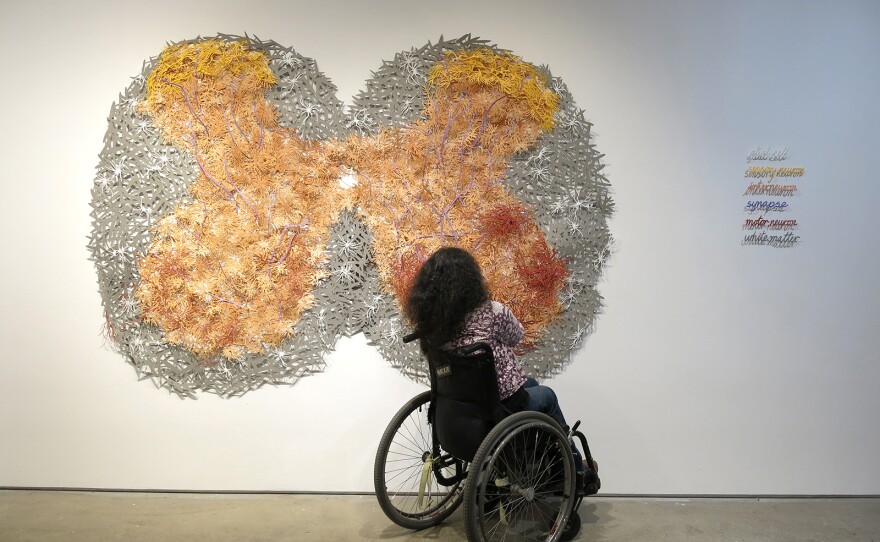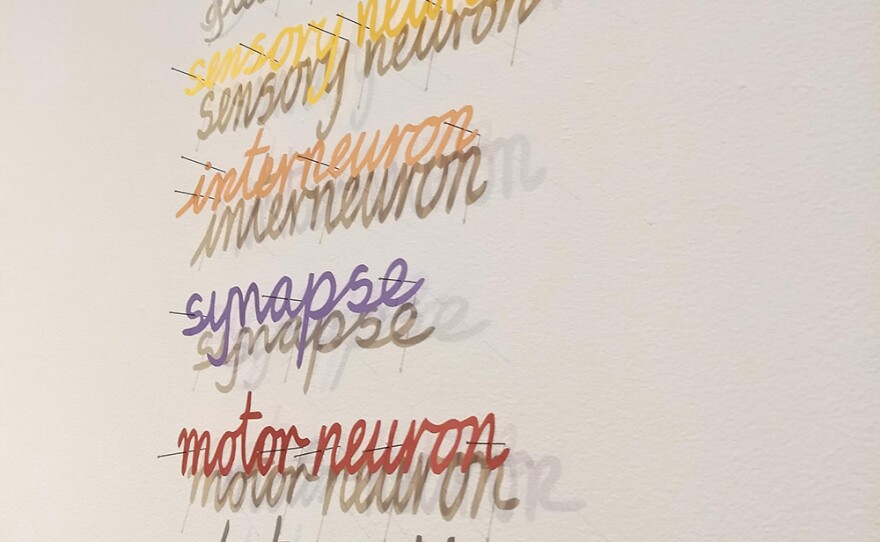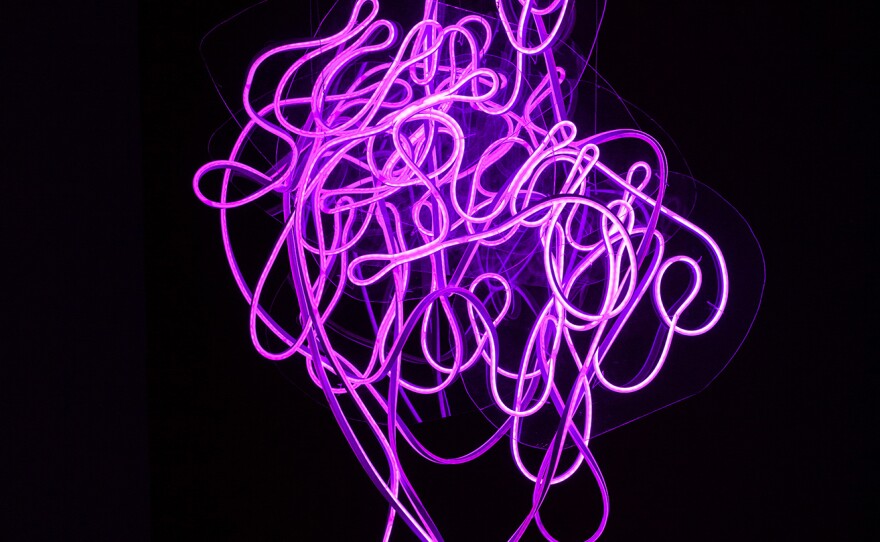Decades of scientific progress will converge with the work of dozens of San Diego artists in a major new group show, "Illumination," at San Diego Art Institute (SDAI) in Balboa Park.
One component of the exhibition paired 16 San Diego artists with local scientists studying in a field of interest to the artist. Scientists like Zbigniew Mikulski from the La Jolla Institute of Immunology, Lu-Lin Jiang from Sanford Burnham Prebys Medical Discovery Institute, Krishna Vadodaria from the Salk Institute, Ben Frable from Scripps Institute of Oceanography and more.
The artists spent time in the lab with their matched scientists, furthering their knowledge of a particular research project and developing a piece of work that reflected the science itself, the interactions with the research or researchers or anything that sprung from the collaboration.
When curator Chi Essary asked San Diego-based paper artist and sculptor Bhavna Mehta to participate and to pitch a topic she'd like to work with, Mehta took a gamble: Pitch something too specific. Mehta, who was stricken with polio as a child, selected contagious diseases of the spinal cord, assuming that the idea was too narrow, and it would be unlikely that the project would find a willing scientist for a pairing. It was a last-ditch effort of steering her work away from something she hadn't yet tackled as an artist: her own spine.
"It was a true dread," she said about making art about her own body. "It's not that I've been avoiding it, it's just that I haven't found the language to do it."

Essary, however, delivered. Mehta visited Dr. Samuel Pfaff at the Salk Institute's Gene Expression Laboratory, which specifically studies motor neurons and diseases of the spinal cord. "I have a real deep personal connection with the Salk Institute," Mehta said. Researchers from the lab also visited Mehta's studio to learn more about her work.
One revelation for Mehta throughout the process was the fundamental intersections of art and science: the value of questions and the pursuit of the unexpected.
"I don't make a lot of art expecting something, because I think you're always disappointed," she said, and felt similarity with the scientists. "You're willing to be surprised by what you find."
Mehta's piece, a massive installation called "Fault Lines," uses hundreds of small paper cut forms and pins to create a cross section of her spinal cord.
The spinal cord is like a superhighway of activity and information, with motor neurons sending messages through the entire body and controlling activity, sensation and what Mehta described as "the involuntary dance of organs." These elements are represented by gray, white, yellow, vivid orange and purple shapes, pinned directly to the wall in 3-dimensional relief. These are the specific tiny things that polio ravages, blown up to 200 times their size.
"It's always going to be painful for me," Mehta said, about the process of creating this piece and understanding her own history. "But the purpose of art is not to show but to discover."

Another impactful pairing in the project was that of scientists Zbigniew Mikulski ("Dr. Z") and Dr. Sara McArdle with filmmaker Cy Kuckenbaker.
"It was very much like giving a little kid a video game joystick for the first time," Kuckenbaker said. With access to one of the La Jolla Institute of Immunology's microscopes over the course of three extended visits to the lab, he began to understand the magnitude of the information stored in each cell in the human body.
Kuckenbaker's project includes a video installation, but strikingly, he also printed out all of the data included in a single chromosome, one of the smallest: chromosome 22. "It took five days to print," he said.
Each page is a combination of base pairs represented by the letters GCAT in sequences for 10,000 pages, or 5,000 sheets of paper. That's just for one chromosome. Each cell contains a whopping 46 of these chromosomes including the copies, and the human body contains trillions of cells. For Kuckenbacker, creating a tangible work of art from these quantifiable but astronomic facts is a way of understanding — and relating — something unfathomable.
The pages are bound into a book that, when set on the floor, reaches about knee height. For Kuckenbaker, it shows the "extraordinary efficiency in nature."

To round out the show, SDAI invited 10 more local artists to show pieces. These artists all routinely create work that deals with technology, climate, global health or other scientifically relevant themes, including Yasmine Kasem, and Los Angeles-based Young Joon Kwak, who created a bright pink twisted neon sculpture for the exhibition.
Other examples include John Burnett, an artist and a sound researcher at the Qualcomm Institute at UC San Diego. Burnett created three different soundscapes for his installation, which aims to provide an immersive audio experience related to everyday technologies.
“It’s very algorithmic how people interact with their phones, swiping various directions and saying yes or no to things and organizing data. So I used these algorithmic processes to produce the sound in this particular piece," Burnett said.
"I don’t really see a division between art and technology, even with paint I see that as a technology producing color. These tools have just become very complex as time has gone along, so the canvas that’s available to artists is quite expansive with the state of technology.”
And that broad canvas is evident here. Another artist, Trish Stone, also with the Qualcomm Institute worked with the San Diego Art Institute to put this exhibit together. She created this piece in response to the 2016 election of Donald Trump.

“I knew I wanted to talk about revolution to talk about overthrowing the government and part of my reason for printing one hundred 'Trishes' was because I thought I needed at least one hundred to accomplish those goals.”
Her work takes computer programming language and applies it to the concepts of protest and community organizing. Coding lingo is painted across the protest signs her figurines are holding.
“Little bits of code that also have another meaning in English. The code for run [to run a program] is just a dot and a slash, but it’s also what we tell protesters to do if someone is too harsh with them," Stone said.
The exhibition, which opened Saturday, Feb. 8 with an opening reception, runs through May 3 at SDAI in Balboa Park. Admission is free to San Diego Art Institute for the entirety of 2020.
Correction: An earlier version of this story incorrectly identified base pairs. The story has been updated to reflect the change.







